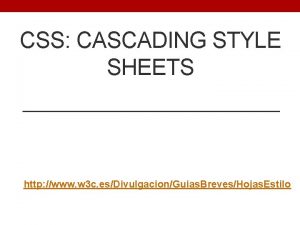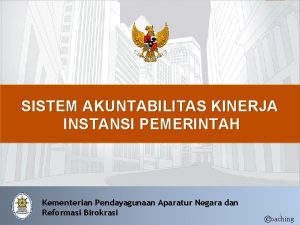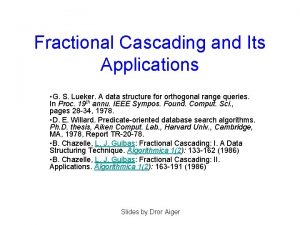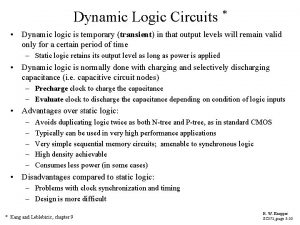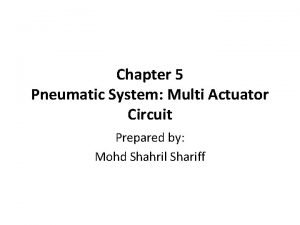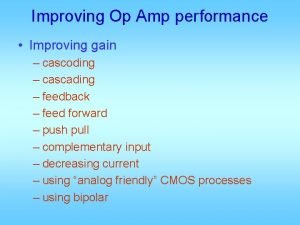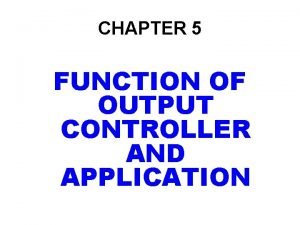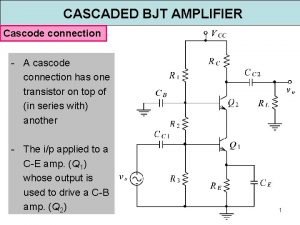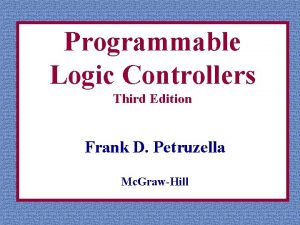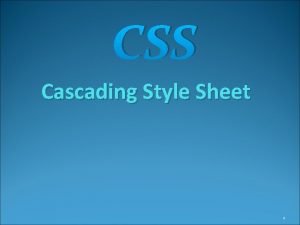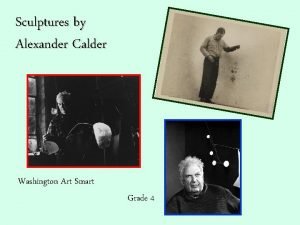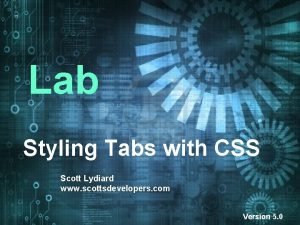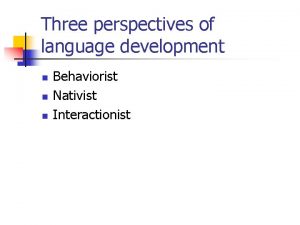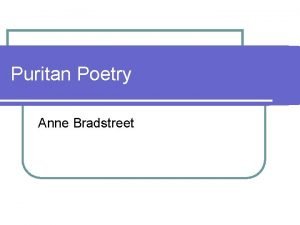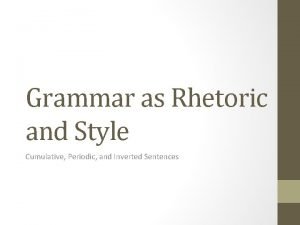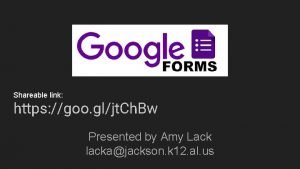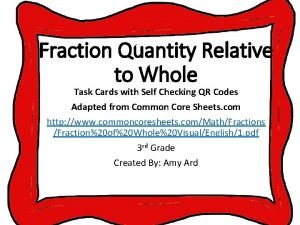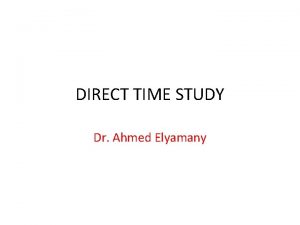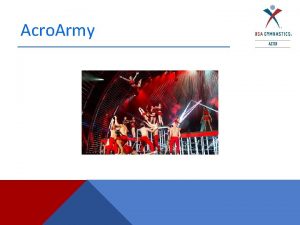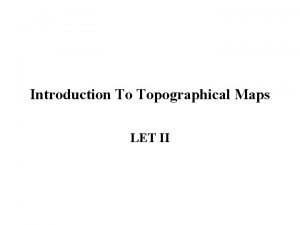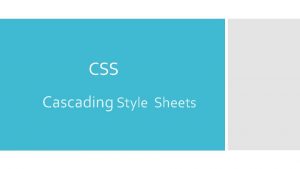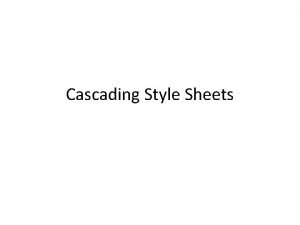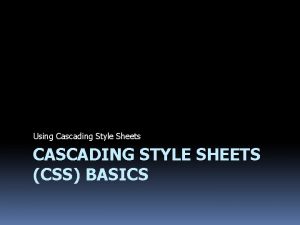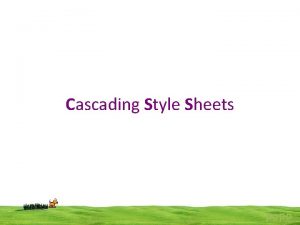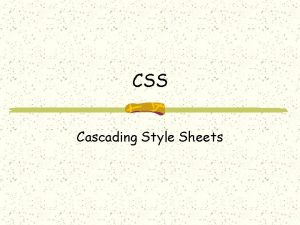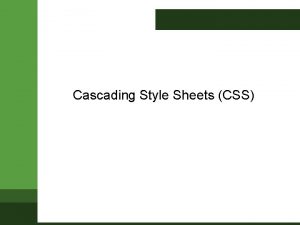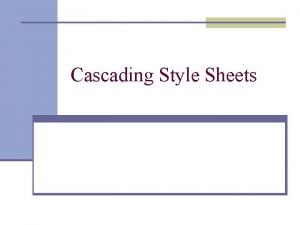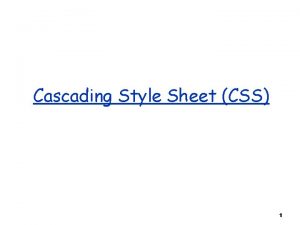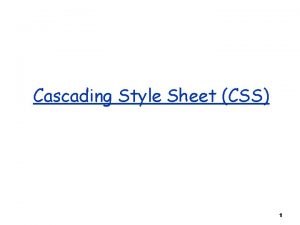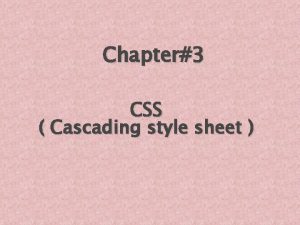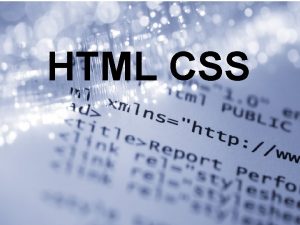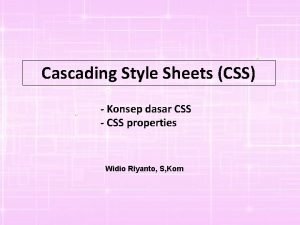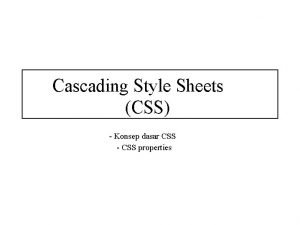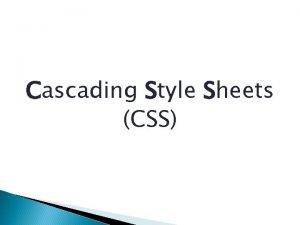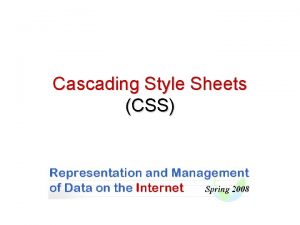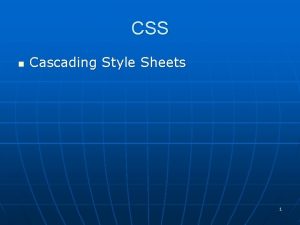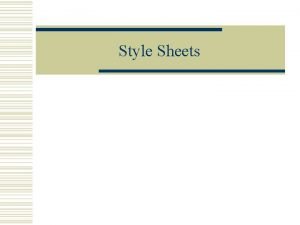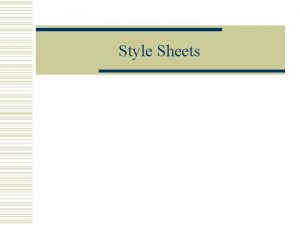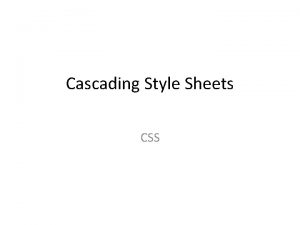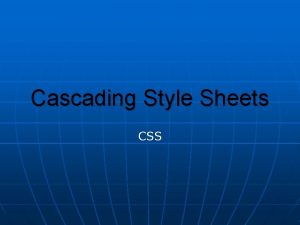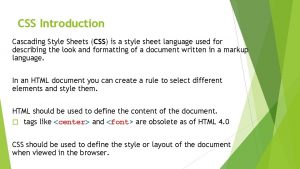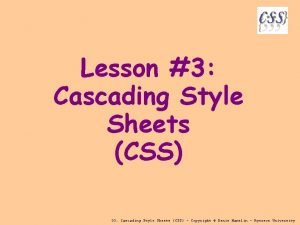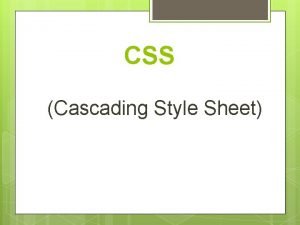Chapter 4 Introduction to Cascading Style Sheets CSS





















































- Slides: 53

Chapter 4 Introduction to Cascading Style Sheets (CSS) Internet & World Wide Web How to Program, 5/e 1

2

3

4. 1 Introduction Cascading Style Sheets 3 (CSS 3) § Used to specify the presentation of elements separately from the structure of the document. CSS validator jigsaw. w 3. org/css-validator/ § This tool can help you make sure that your code is correct and will work on CSS 3 -compliant browsers. 4

4. 2 Inline Styles Inline style § declare an individual element’s format using the HTML 5 attribute style. Figure 4. 1 applies inline styles to p elements to alter their font size and color. Each CSS property is followed by a colon and the value of the attribute § Multiple property declarations are separated by a semicolon 5

最好的方法是用external link 6

7

8

4. 2 Inline Styles (Cont. ) color property sets text color § Color names and hexadecimal codes may be used as the color property value. § Figure 4. 2 contains the HTML standard color set. § A list of extended hexadecimal color codes and color names is provided in Appendix B. § You can also find a complete list of HTML standard and extended colors at www. w 3. org/TR/css 3 -color/ 9

10

4. 3 Embedded Style Sheets A second technique for using style sheets is embedded style sheets, which enable you to embed a CSS 3 document in an HTML 5 document’s head section. Figure 4. 3 creates an embedded style sheet containing four styles. 11

12

13

14

4. 3 Embedded Style Sheets (cont. ) The style Element and MIME Types (What is MIME type? ) Styles that are placed in a style element use selectors to apply style elements throughout the entire document style element type attribute specifies the MIME type (the specific encoding format) of the style sheet. Style sheets use text/css. Figure 4. 4 lists common MIME types used in this book. For a complete list, visit: § www. w 3 schools. com/media_mimeref. asp 15

16

CSS Rules A CSS rule has two main parts: a selector, and one or more declarations. Source: http: //www. w 3 schools. com/ 17

4. 3 Embedded Style Sheets (cont. ) The style sheet’s body declares the CSS rules for the style sheet. To achieve the separation between the CSS 3 code and the HTML 5 that it styles, we’ll use a CSS selector to specify the elements that will be styled according to a rule. An em element indicates that its contents should be emphasized. Each rule body in a style sheet is enclosed in curly braces ({ and }). 18

4. 3 Embedded Style Sheets (Cont. ) font-weight property specifies the “boldness” of text. Possible values are: § § § bold normal (the default) bolder (bolder than bold text) lighter (lighter than normal text) Boldness also can be specified with multiples of 100, from 100 to 900 (e. g. , 100, 200, …, 900). Text specified as normal is equivalent to 400, and bold text is equivalent to 700 19

4. 3 Embedded Style Sheets (Cont. ) Style Classes � Style-class declarations are preceded by a period (. ). (class selector) define styles that can be applied to any element. � In this example, class special sets color to purple. � You can also declare id selectors. � If an element in your page has an id, you can declare a selector of the form #element. Id to specify that element’s style. � They 20

4. 3 Embedded Style Sheets (Cont. ) font-family Property font-family property specifies the name of the font to use. § Generic font families allow authors to specify a type of font instead of a specific font, in case a browser does not support a specific font. 21

22

4. 3 Embedded Style Sheets (Cont. ) font-size Property property specifies the size used to render the font. You can specify a point size or a relative value such as xx-small, smaller, medium, larger, x-large and xx-large. Relative font-size values are preferred over points, because an author does not know the specific measurements of each client’s display. Relative values permit more flexible viewing of web pages. font-size § For example, users can change font sizes the browser displays for readability. 23

4. 3 Embedded Style Sheets (Cont. ) Applying a Style Class In many cases, the styles applied to an element (the parent or ancestor element) also apply to the element’s nested elements (child or descendant elements). Multiple values of one property can be set or inherited on the same element, so the browser must reduce them to one value for that property per element before they’re rendered. We discuss the rules for resolving these conflicts in the next section. 24

4. 4 Conflicting Styles Figure 4. 3 contains an example of inheritance in which a child em element inherits the font-size property from its parent p element. However, in Fig. 4. 3, the child em element has a color property that conflicts with (i. e. , has a different value than) the color property of its parent p element. Properties defined for child and descendant elements have a higher specificity than properties defined for parent and ancestor elements. Conflicts are resolved in favor of properties with a higher specificity, so the child’s styles take precedence. Figure 4. 6 illustrates examples of inheritance and specificity. 25

Defines the class nodec that can only be used by anchor elements Sets the properties for the hover pseudoclass for the a element, which is activated when the user moves the cursor over an anchor element All em elements that are children of li elements set to bold Applies underline style to all h 1 and em elements 26

27

28

29

4. 4 Conflicting Styles (Cont. ) Pseudoclasses give you access to content that’s not declared in the document. hover pseudoclass is activated when the user moves the mouse cursor over an element. 30

31

4. 4 Conflicting Styles (Cont. ) Relative length measurements: § § px (pixels – size varies depending on screen resolution) em (usually the height of a font’s uppercase M) ex (usually the height of a font’s lowercase x) Percentages (of the font’s default size) § § § in (inches) cm (centimeters) mm (millimeters) pt (points; 1 pt = 1/72 in) pc (picas; 1 pc = 12 pt) Absolute-length measurements (units that do not vary in size): 32

33

4. 5 Linking External Style Sheets External style sheets are separate documents that contain only CSS rules. Help create a uniform look for a website § Separate pages can all use the same styles. § Modifying a single style-sheet file makes changes to styles across an entire website (or to a portion of one). When changes to the styles are required, you need to modify only a single CSS file to make style changes across all the pages that use those styles. This concept is sometimes known as skinning. 可設計一個可以適用於整個website的CSS 34

4. 5 Linking External Style Sheets (Cont. ) Figure 4. 7 presents an external style sheet. CSS comments may be placed in any type of CSS code (i. e. , inline styles, embedded style sheets and external style sheets) and always start with /* and end with */. 35

36

4. 5 Linking External Style Sheets (Cont. ) Figure 4. 8 contains an HTML 5 document that references the external style sheet. link element § Uses rel attribute to specify a relationship between two documents § rel attribute declares the linked document to be a stylesheet for the document type attribute specifies the MIME type of the related document href attribute provides the URL for the document containing the style sheet 37

38

39

40

41

4. 6 Positioning Elements: Absolute Positioning, z-index CSS position property § Allows absolute positioning, which provides greater control over where on a page elements reside § Normally, elements are positioned on the page in the order in which they appear in the HTML 5 document § Specifying an element’s position as absolute removes it from the normal flow of elements on the page and positions it according to distance from the top, left, right or bottom margin of its parent element 42

43

44

45

4. 6 Positioning Elements: Absolute Positioning, z-index (Cont. ) The z-index property allows a developer to layer overlapping elements Elements that have higher z-index values are displayed in front of elements with lower z-index values 46

4. 7 Positioning Elements: Relative Positioning, span Figure 4. 10 demonstrates relative positioning, in which elements are positioned relative to other elements. 47

48

49

50

<div> v. s. <span> <div> § The <div> tag defines a division or a section in an HTML document. § The <div> tag is a block-level element. (會換行) § The <div> tag is often used to group block-elements to format them with styles. <span> § The <span> tag provides no visual change by itself. § The <span> tag is an inline-level element. (不會換行) § The <span> tag provides a way to add a hook to a part of a text or a part of a document. 這兩個tag對於CSS和Java. Script很重要 51

Resources Tutorial: § http: //css 3. bradshawenterprises. com/ HTML Formatter: § http: //www. freeformatter. com/html-formatter. html CSS Formatter: § http: //www. cleancss. com/css-beautify/ 100

Resources 所有顏色代碼: 挖出特定網站的配色: 色票: § http: //www. 0 to 255. com/ § http: //stylifyme. com/ § https: //color. adobe. com/zh/explore/ § http: //coolors. co/ 53
 Cascading style sheets outlook
Cascading style sheets outlook Cascading style sheets definition
Cascading style sheets definition Syntactically awesome style sheets
Syntactically awesome style sheets A css comprises of style rules that are interpreted
A css comprises of style rules that are interpreted Css button style generator
Css button style generator Perbedaan cascading dan pohon kinerja
Perbedaan cascading dan pohon kinerja Fractional cascading
Fractional cascading Dynamic shift register
Dynamic shift register Cascade method in pneumatic
Cascade method in pneumatic Integrated strategy map
Integrated strategy map Cascading consequences
Cascading consequences Cascading behavior in networks
Cascading behavior in networks Cascading op amps
Cascading op amps Cascading timers
Cascading timers Dc analysis of cascode amplifier
Dc analysis of cascode amplifier Interconnecting or cascading two plc counters involves
Interconnecting or cascading two plc counters involves Beda pohon kinerja dan cascading
Beda pohon kinerja dan cascading Cascading order
Cascading order Cascading effects
Cascading effects Cascading flowers calder
Cascading flowers calder Copy text from image
Copy text from image Cascading rpjmd
Cascading rpjmd Budgets and balance sheets chapter 4
Budgets and balance sheets chapter 4 Business letter format mla
Business letter format mla Informal vs formal tone
Informal vs formal tone Formal tone vs informal tone
Formal tone vs informal tone Nnn speech
Nnn speech Plain style vs high style
Plain style vs high style Cumulative sentence
Cumulative sentence Progress monitoring google sheets
Progress monitoring google sheets Wellcomm section 4
Wellcomm section 4 Production sheets food service
Production sheets food service Math is not an essential skill for foodservice managers.
Math is not an essential skill for foodservice managers. Intestinal glands
Intestinal glands Draw sheets are used to
Draw sheets are used to Googlw sheets
Googlw sheets Letter of recommendation brag sheet
Letter of recommendation brag sheet Presidential youth fitness test
Presidential youth fitness test Prenatal massage spring tx
Prenatal massage spring tx Nysdot work zone traffic control manual
Nysdot work zone traffic control manual Moving and handling dementia patients
Moving and handling dementia patients Electronic data sheets
Electronic data sheets Hics level 1
Hics level 1 Fraction quantity relative to whole
Fraction quantity relative to whole Time study sheets
Time study sheets Correlation coefficient google sheets
Correlation coefficient google sheets Brigance cutoff scores
Brigance cutoff scores Brigance data sheets
Brigance data sheets Grade 4 acrobatic gymnastics tariff sheets
Grade 4 acrobatic gymnastics tariff sheets Job cost sheets constitute the subsidiary ledger for the
Job cost sheets constitute the subsidiary ledger for the Le grand concours practice test
Le grand concours practice test Ma dese mcas accommodations
Ma dese mcas accommodations Topographic map introduction
Topographic map introduction Tg scaffolding
Tg scaffolding

